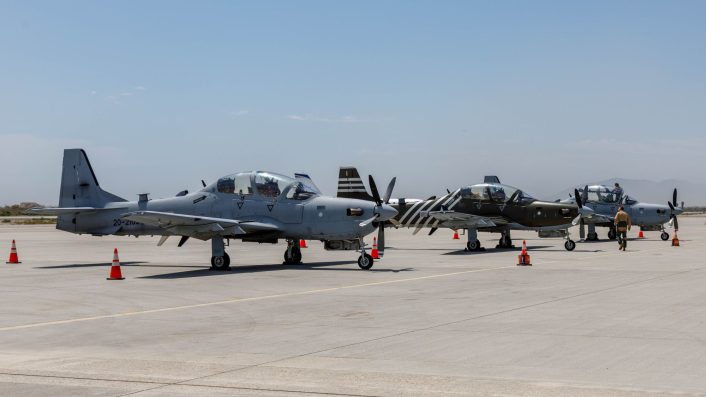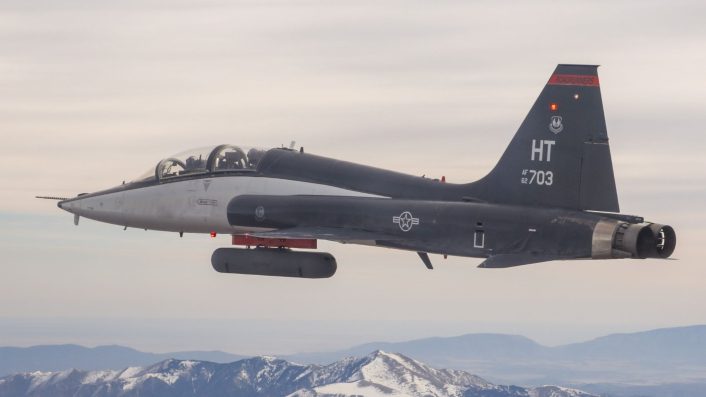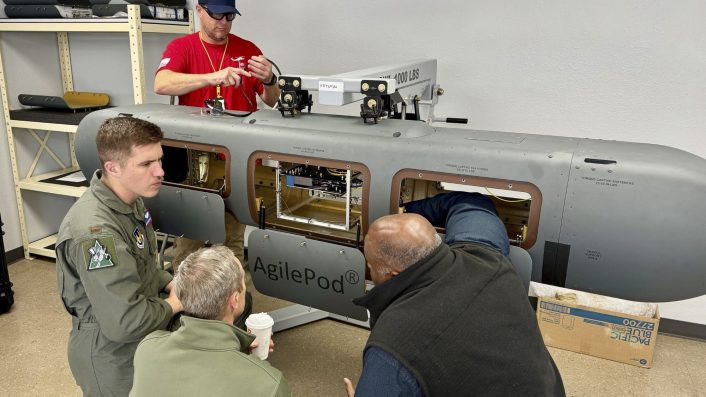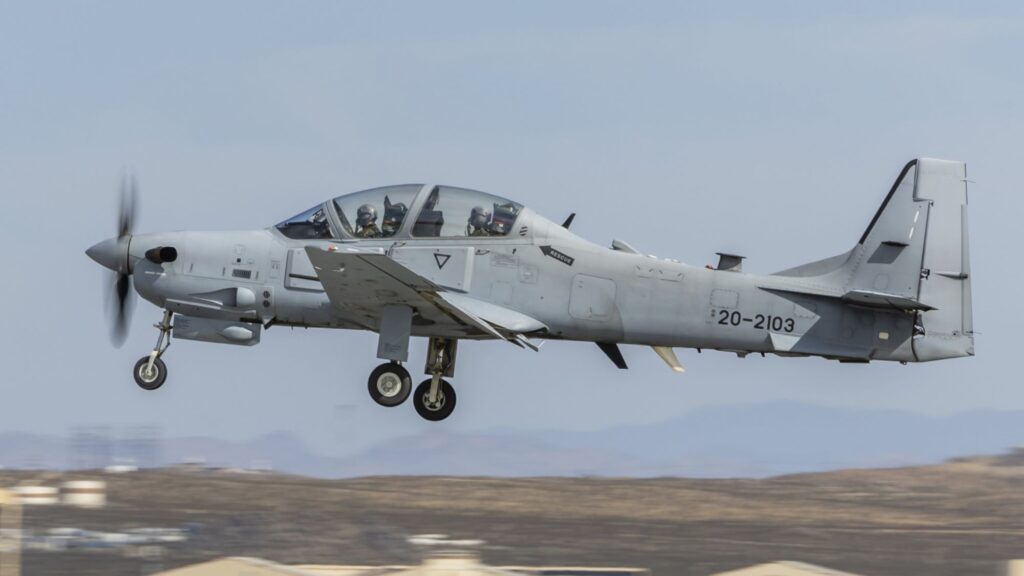The A-29C will be used both for training as part of the Test Pilot School’s curriculum and experimental testing of mission systems, avionics, sensors and weapons.
The A-29C Super Tucanos of the U.S. Air Force Test Pilot School commenced their training operations at Edwards AFB in California, a press release from the 412th Test Wing said. This comes nearly a year after three of the aircraft arrived at Edwards on Jul. 18, 2024, after being temporarily stored at Davis-Monthan AIr Force Base, Arizona.
The aircraft were initially acquired by the Air Force Special Operations Command (AFSOC) for the Light Attack/Armed Reconnaissance (LAAR) program that envisioned having 100 aircraft for counter-insurgency roles, including Close Air Support (CAS) and Intelligence, Surveillance and Reconnaissance (ISR). The aircraft were then stored after the conclusion of the experimental program following a change of the mission requirements.
The Embraer A-29 would now help expand the training curriculum at the TPS as a “modern platform for instruction in aerial spins, sensors and mission systems training,” the release explained. It would also serve as an “additional aircraft type for data collection during research projects” of the TPS Research Division.
Happy Tucano Tuesday!
The A-29C has formally began integration into the #USAF Test Pilot School’s curriculum.
Hear from our chief pilot on why the Super Tucano will enhance student instruction and broader industry #research. @HQ_AFMC https://t.co/hLCSIBbmaw pic.twitter.com/mlJzvmGjL3
— Edwards Air Force Base (@EdwardsAFB) July 8, 2025
The 412th Test Wing, the Air Force Test Center (AFTC) and the Sierra Nevada Corporation – that has a Super Tucano assembly facility at Jacksonville, Florida – will work together in maintaining and sustaining the aircraft “providing critical cutting-edge instruction to future test leaders.”
Preparing flying and maintenance procedures for the new aircraft
The A-29’s “limited use” made it “one of the few aircraft within the current USAF inventory that lacks a formal training course.” Thus, three instructors from the TPS, one of them being Maj. Mateusz Borek – the flight sciences assistant department chair and chief A-29 test pilot, had to fly the aircraft to Edwards AFB with “zero formal flight training” on the type.
This appears to be a reference to the flight from Davis-Monthan AFB to Edwards AFB in July 2024. “They prepared by studying the flight manual, engaging in discussions with maintenance personnel, and studying what is known as the 3-3 publication, or key tactics, techniques, and procedures that are unique to the aircraft,” the release explained, describing the preparation for the ferry flight.
To further mitigate risk associated with operating a new aircraft for the first time, the instructors also completed qualification flights in the T-6 Texan and the PC-21, “which have similar flying and handling characteristics.” It is worth noting, however, that the three A-29s were previously used by the now deactivated 81st Fighter Squadron to train foreign nations, such as Afghanistan and Nigeria, and it is unclear if the instructors were able to retrieve training material which was used by the 81st FS until 2022.

“Even though I wasn’t testing the A-29C per se, the thrill of getting into an aircraft I’ve never flown before, solo, was unmatched,” said Maj. Borek. “I studied the flight manual meticulously and mentally rehearsed the flight. The USAF Test Pilot School had a big hand in preparing me for scenarios such as this one. While I was a student, I flew more than 20 different airplanes. The school didn’t provide me with extraordinary abilities; instead, it taught me critical thinking and evaluation skills that can only be gained with countless hours of academics, sims, and hands-on experiences.”
Upon safely arriving at Edwards AFB, the 412th Test Wing and Sierra Nevada Corporation collaborated for the next six months and put the A-29s through “extensive maintenance.” At the same time, “this allowed instructors to thoroughly study the aircraft, refine procedures, and develop a comprehensive training plan,” said the service.
Expanded testing – From flight and piloting
The A-29C’s modern avionics and robust airframe design make it one of the few aircraft in the USAF’s Test Pilot School curriculum to be utilized for both flight training, pilot instruction, and experimental testing of mission systems, avionics, sensors and weapons, explained the press release. The TPS called it the “jack-of-all-trades.”
A-29 Super Tucano aircraft inducted into @NigAirForce
“The total package deal—aircrew & maintainer training, precision-guided weapon delivery, & more—highlights our enduring partnership w/the Nigerian Air Force…”
– Gen. Harrigian, @HQUSAFEAFAF commanderhttps://t.co/ZYQkkRR3Sa pic.twitter.com/Et4jMrAzIn— U.S. Africa Command (AFRICOM) (@USAfricaCommand) August 31, 2021
For training test pilots, the A-29C Super Tucano will “primarily be used for stall and spin training,” because “evaluating and testing aircraft stall and spin characteristics is a crucial skill set for every graduate of a test pilot school.” The new A-29Cs will be able to “execute many types of spins with an endurance of over 1 ½ hours, maximizing learning for all students.”
Currently, the Air Force uses for this role a glider spin sortie, which however offers “limited repetitions and flight dynamics,” and an F-16 departure flight, which is only applicable to graduates who go on to test fighter aircraft.
Testing instruments, avionics, drones, sensors and weapons
Upon establishing and finalizing logistics and piloting procedures, the TPS curriculum will utilize the A-29C’s mission systems also for testing and trialing avionics, sensors and weapons. “The aircraft can carry an MX-15 Sensor Ball, utilize Link 16, communicate through a VORTEX link, and employ laser-guided bombs and rockets,” said the release.
Aviators training to become test pilots at the TPS will receive the “knowledge and skills necessary to test and evaluate similar mission systems on current and emerging platforms.”
#ICYMI SNC continues to support U.S. Air Force Special Operations Command’s critical mission with the delivery of three U.S.-built A-29C Super Tucanos – the most technologically enhanced & mission-capable A-29 on the market. #CombatProven #TeamSNC https://t.co/SgZzuAggCz pic.twitter.com/s4bYLiEpHP
— Sierra Nevada Corporation (@SierraNevCorp) April 20, 2022
Another benefit would be sparing critical airframe life of the F-16s at Edwards AFB that are usually flown for the Sensors Demo, Weapons Demo, and Mission Systems Practical Exam. These can be “uniquely performed on the A-29C,” said the release.
Towards that end, the TPS is currently equipping the A-29C Super Tucanos with “special instrumentation to enable advanced data collection and control room operations.” This will allow it to easily collect data about every aspect of a flight mission, allowing in turn a thorough debrief and data analysis.

The school is also exploring the potential integration of the Agile Pod, which would further enhance the mission systems capabilities.The AgilePod is an Air Force-trademarked, multi-intelligence reconfigurable pod, available in various form factors, enabling rapid integration of new airborne data and communications technologies onto existing certified platforms. It eliminates the need for developers to engage with multiple aircraft procurement and sustainment offices and design custom packaging solutions.
With its five underwing weapon stations, the A-29C also allows future flexibility for research and development efforts through the Air Force Test Pilot School’s Research Division. Its backseat also houses a dedicated controller station that could be used for combat systems officers and remotely piloted aircraft students Collaborative Combat Aircraft (CCA) and Manned-Unmanned Teaming (MUM-T) technologies and concepts evolve.

In the release announcing the arrival of the A-29s at Edwards AFB in July 2024, AFTC plans and programs director Michael Banzet called the repurposing of the aircraft for flight testing “a result of thoughtful analysis by the Test Pilot School […] to take advantage of a unique, fleeting opportunity.” He further added “not only does this repurpose a $63 million taxpayer investment, it also modernizes and expands TPS curriculum to accelerate the fielding of combat capability for the U.S. Air Force.”

